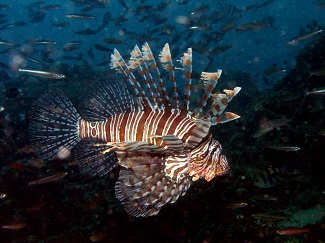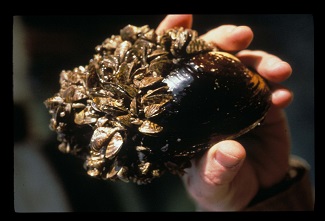Aquatic Nuisance Species (ANS)
- What are aquatic nuisance species?
- How do aquatic nuisance species spread?
- As a vessel owner/operator, how can I help prevent the spread of aquatic nuisance species?
- How is the EPA involved in addressing aquatic nuisance species?
What are aquatic nuisance species?
Aquatic nuisance species are organisms that disrupt the ecological stability of infested inland (e.g., rivers and lakes), estuarine or marine waters. Beyond doing ecological damage, the infestation may impair the recreational, commercial and agricultural uses of the water body.
How do aquatic nuisance species spread?
 The lionfish is an Indo-Pacific fish that has invaded Caribbean and western Atlantic Ocean waters from North Carolina to Florida. (Photo: Julie Bedford/NOAA)There are many pathways for invasion by aquatic nuisance species. Globalization has vastly increased long-distance travel and commerce, and highly altered waterways. These and other factors have increased the frequency by which nonindigenous plants, animals and pathogens are introduced to new areas, sometimes with costly results. Some of the more common pathways are listed below.
The lionfish is an Indo-Pacific fish that has invaded Caribbean and western Atlantic Ocean waters from North Carolina to Florida. (Photo: Julie Bedford/NOAA)There are many pathways for invasion by aquatic nuisance species. Globalization has vastly increased long-distance travel and commerce, and highly altered waterways. These and other factors have increased the frequency by which nonindigenous plants, animals and pathogens are introduced to new areas, sometimes with costly results. Some of the more common pathways are listed below.
- Ballast water
- Boat hulls, fishing gear and other recreational pathways
- Aquaculture escapes
- Intentional introductions
- Aquaria releases
- Live food industry
- Escaped ornamental plants, nursery sales or disposals
- Fishing bait releases
- Illegal stockings
As a vessel owner/operator, how can I help prevent the spread of aquatic nuisance species?
 The zebra mussel was introduced to the Great Lakes in the late-1980s, most likely from being transported in the ballast water of ocean-going vessels. In this image, zebra mussels are attached to a native mussel. (Photo: U.S. Fish and Wildlife Service) Boating activities can contribute to the problem of aquatic nuisance species. These species can "hitchhike" from one body of water to another by:
The zebra mussel was introduced to the Great Lakes in the late-1980s, most likely from being transported in the ballast water of ocean-going vessels. In this image, zebra mussels are attached to a native mussel. (Photo: U.S. Fish and Wildlife Service) Boating activities can contribute to the problem of aquatic nuisance species. These species can "hitchhike" from one body of water to another by:
- Attaching to portions of your boat (e.g., hull, rudder, anchor) or trailer
- Attaching to recreational equipment such as fishing gear, water floats and snorkeling equipment
- Being carried in the bilge, ballast tank or live well
Many state agencies recommend inspecting boats, trailers and recreational equipment before use and after use; removing any attached plants or animals; and, if possible, disposing of them in a manner such that they cannot reenter the water.
If you are planning to move your boat to a different water body, recommended practices include thoroughly cleaning, draining and drying your boat prior to transporting it to a new location.
How is the EPA involved in addressing aquatic nuisance species?
The EPA is an active participant in the Aquatic Nuisance Species (ANS) Task Force, an intergovernmental organization dedicated to the prevention and control of aquatic nuisance species in the United States. For more information on this work, visit the ANS Task Force website by clicking HERE.Exit
The EPA is also involved in research to detect and monitor aquatic nuisance and invasive species, which you can read about HERE. In 2008, the EPA produced a report entitled, "Effects of Climate Change on Aquatic Invasive Species and Implications for Management and Research." This report can be accessed HERE.Exit
In addition, the EPA addresses aquatic nuisance species using numerous regulatory tools. The EPA's National Pollutant Discharge Elimination System (NPDES) Vessel General Permit (VGP) and Small Vessel General Permit (sVGP) regulate discharges incidental to the normal operation of commercial vessels, including ballast water and hull fouling, which are both pathways for introductions of aquatic nuisance species. The EPA and the Department of Defense are jointly developing the Uniform National Discharge Standards for vessels of the Armed Forces which will also regulate ballast water and hull fouling to help control the introduction of aquatic nuisance species.
